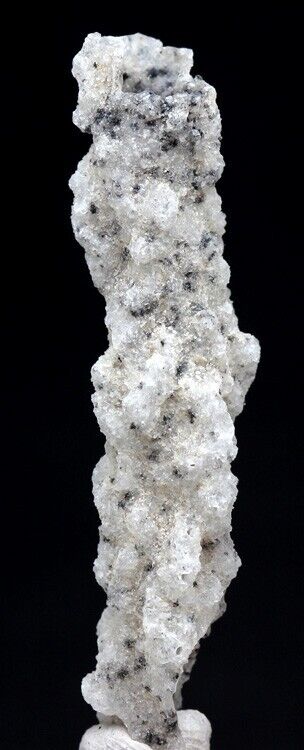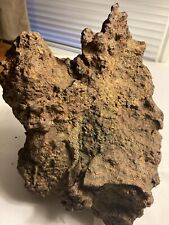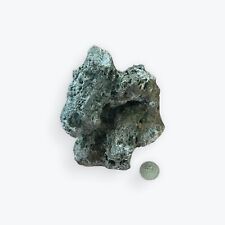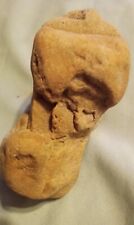AMAZING FULGURITE Lightning Glass Sand Mineral Specimen FLORIDA For Sale

When you click on links to various merchants on this site and make a purchase, this can result in this site earning a commission. Affiliate programs and affiliations include, but are not limited to, the eBay Partner Network.
AMAZING FULGURITE Lightning Glass Sand Mineral Specimen FLORIDA:
$34.95
This specimen weighs 1.73 grams. It measures 51 mm x 11 mm x 11 mm.I offer a shipping discount for customers who combine their payments for multiple purchases into one payment!The discount is regular shipping price for the first item and just 50 cents for each additional item!To be sure you get your shipping discount just make sure all the items you want to purchase are in your cart.sales you win are added to your cart automatically.For any \"buy it now\" items or second chance offers, be sure to click the \"add to cart\" button, NOT the \"buy it now\" button.Onceall of your items are in your cart just pay for them from your cart andthe combined shipping discount should be applied automatically.
I offer a money back guarantee on every item I sell.If you are not 100% happy with your purchase just send me a message to let me knowand I will buy back the item for your full purchase price.
Hi there. I am selling this really awesome fulgurite mineral specimen. This was discovered in Florida. THIS IS WHAT HAPPENS TO SAND WHEN IT GETS STRUCK BY LIGHTNING! It instantly fuses into this amazing glass! I love this stuff, it is one of my favorite minerals! If you have any questions, do not hesitate to ask me. Have fun offerding, thanks so much for visiting my sale and have a great day!
The following is a wikipedia entry about this mineral:FulguriteFrom Wikipedia, the free encyclopedia
FulguriteStereo image[show]Left frame[hide]Right frameFulgsdcr.jpg[show]Parallel view (Stereogram guide parallel.png)[show]Cross-eye view (Stereogram guide cross-eyed.png)Two Type I (arenaceous) fulgurites: a common tube fulgurite and a more irregular specimen.Stereo image[show]Left frame[hide]Right frameFulgsdcrb.jpg[show]Parallel view (Stereogram guide parallel.png)[show]Cross-eye view (Stereogram guide cross-eyed.png)Two small Type I Saharan Desert fulgurites. In a planar view the specimen on the right has a blade-like morphology, but its tubular nature is dramatically shown in a stereo view.
metric attributesFulgurites (from the Latin fulgur, meaning \"lightning\") are natural tubes, clumps, or masses of sintered, vitrified, and/or fused soil, sand, rock, organic debris and other sediments that can form when lightning discharges into ground. They are classified as a variety of the mineraloid lechatelierite, although their absolute chemical composition is dependent on the physical and chemical properties of the usually granular-crystalline material providing an electrically and thermally conductive dissipation network for lightning-facilitated energy transfer. They are commonly hollow and/or branching assemblages of glassy, protocrystalline, and heterogeneously microcrystalline tubes, crusts, slags, vesicular masses, and clusters of refractory materials that often form during the discharge phase of lightning strikes propagating into silica-rich quartzose sand, mixed soil, clay, or other sediments.[1][2] Fulgurites are homologous to Lichtenberg figures, which are the branching patterns produced on surfaces of insulators during dielectric breakdown by high-voltage discharges, such as lightning.[3][4]
Contents [hide]1 Description2 Classification3 Place in planetary processes and the geologic record4 In material culture5 Gallery6 See also7 References8 External linksDescription[edit]Fulgurites are formed when lightning strikes the ground, fusing and vitrifying mineral grains.[5] The peak temperatures within a lightning channel are known to exceed 30,000 K, with sufficient pressure to produce planar deformation features, or \"shock lamellae\" in SiO2 polymorphs.[6][7][8] \"Artificial fulgurites\" can also be produced when the controlled arcing of electricity into a fusable medium. Downed high voltage power lines have produced blue, fulgurite-like lechatelierites, colored by copper from the power lines, themselves.[9]
The color of fulgurites varies widely, depending on composition and chemical impurities. Most natural fulgurites fall on a spectrum from white to black, but moderate iron content can result in a deep brownish-green coloration. More colorful variants are usually synthetic and reflect incorporation of synthetic materials. The interior of Type I (sand) fulgurites normally is very smooth or lined with fine bubbles, while other types are often both vesicular and dense or scoria-like; their exteriors generally can be coated with rough sedimentary particles and can be porous, smooth, or structurally complex. Branching fulgurites display fractal-like self-similarity and structural scale invariance as a macroscopic or microscopic network of root-like branches. Fulgurites formed in sand or loose soil are mechanically fragile, making the field collection of large specimens difficult.
The primary SiO2 phase in fulgurites is lechatelierite, a silica glass. Because their groundmass is generally amorphous in structure, fulgurites are classified as mineraloids.
Fulgurites can exceed tens of centimeters in diameter and can penetrate deep into the subsoil, sometimes occurring as far as 15 m (49 ft) below the surface that was struck, but may form directly on appropriate sedimentary surfaces.[10] One of the longest fulgurites to have been found in modern times was a little over 4.9 m (16 ft) in length, and was found in northern Florida.[11] The Yale University Peabody Museum of Natural History displays one of the longest known preserved fulgurites, approximately 4 m (13 ft) in length.[12] Charles Darwin in The Voyage of the Beagle recorded that tubes such as these found in Drigg, Cumberland, UK reached a length of 9.1 m (30 ft).[13][14] The Winans Lake fulgurite[s] (Winans Lake, Livingston County, Michigan), extended discontinuously throughout a 30 m range, and arguably includes the largest reported fulgurite mass ever recovered and described - its largest section extending approximately 16 ft (4.88 m) in length by 1 ft in diameter (30 have been classified by Pasek et al. (2012)[16] into five types related to the type of sediment in which the fulgurite formed, as follows:
Type I - sand fulgurites with tubaceous structure; their central axial void may be collapsedType II - soil fulgurites; these are glass-rich, and form in a wide range of sediment compositions, including clay-rich soils, silt-rich soils, gravel-rich soils, and loessoid; these may be tubaceous, branching, vesicular, irregular/slaggy, or may display a combination of these structures, and can produce exogenic fulgurites (droplet fulgurites)Type III - caliche or calcic sediment fulgurites, having thick, often surficially glazed granular walls with calcium-rich vitreous groundmass with little or no lechatelierite glass; their shapes are variable, with multiple narrow central channels common, and can span the entire range of morphological and structural variation for fulguritic objectsType IV - rock fulgurites, which are either crusts on minimally altered rocks, networks of tunneling within rocks, vesicular outgassed rocks (often glazed by a silicide-rich and/or metal oxide crust), or completely vitrified and dense rock material and masses of these forms with little sedimentary groundmassDroplet fulgurites (exogenic fulgurites), which are exogenous (e.g. spheroidal, botryoidal, filamentous, or aerodynamic),[1][17] related by composition to Type II and Type IV fulguritesPlace in planetary processes and the geologic record[edit]Many observations have been made in fulgurites of high-pressure, high-temperature materials more commonly assumed to be exclusive to meteoritic sources, products of asteroid impacts, comet airbursts, or cosmic dust. Such materials - as a suite - formerly considered to be unique to hypervelocity impacts, have been identified in fulgurites, including highly reduced silicon-metal alloys (silicides), the fullerene allotropes C60 (buckminsterfullerene) and C70, as well as high-pressure polymorphs of SiO2, in phosphorus as phosphides and phosphites have been identified through quantitative analyses of a representative sample of 10 fulgurites recovered from most continents, in the form of schreibersite (Fe3P, (Fe,Ni)3P) - otherwise extremely rare on Earth, but common in meteorites, comets, interplanetary dust, and some planetary bodies - and TiP, which is unique to fulgurites.[2][28][29]
In material culture[edit]A fulgurite was found within the contents of the ash altar at the temple of Lykaian Zeus at Mount Lykaion in Greece. It may be associated with ritual activity performed there.[30][31][32]
Fulgurites are appreciated by many for their value as tangible evidence of lightning strikes.[33] Fulgurites are also popular among hobbyists and collectors of natural specimens.[34]

Related Items:
$187500.00
Fossilized Lightening/ Fulgurite
$50.00
Fulgurite Specimen. 279 Grams. Very Cool Piece.
$62.00



